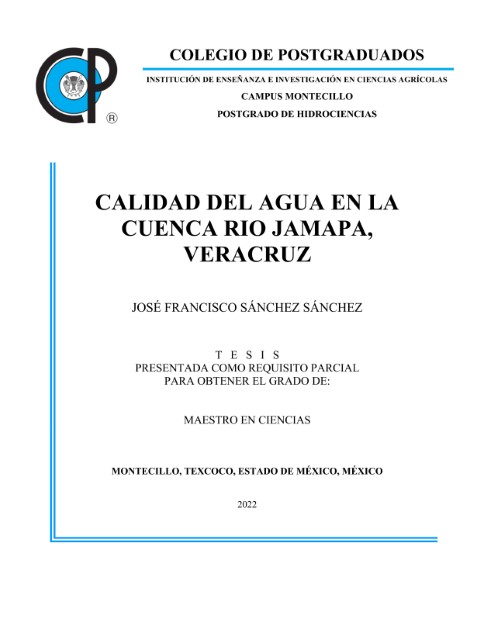
Fecha: 2022-05
JOSÉ FRANCISCO SÁNCHEZ SÁNCHEZ, M. C. Colegio de Postgraduados, 2022
RESUMEN
La calidad del agua de los ríos se afecta por las diversas
cargas de contaminantes que son vertidas principalmente como consecuencia de
diferentes actividades humanas. Esta varía temporal y espacialmente debido al
efecto amortiguador de volúmenes de estiaje y avenidas. En este trabajo se
examinó la calidad del agua en la cuenca hidrográfica del río Jamapa, desde la
zona de las Altas Montañas hasta su desembocadura en el Parque Nacional Sistema
Arrecifal Veracruzano (PNSAV). Se analizó el grado de contaminación en sus dos
afluentes principales, río Jamapa y río Cotaxtla, realizando muestreos en la
época húmeda y en la época seca, en 16 sitios distribuidos tomando en cuenta las
poblaciones con aportes significativos de descarga, las actividades económicas,
el uso de suelo y vegetación en toda la cuenca y, con ayuda de un sistema de
información geográfica, se realizó el análisis espacial de los resultados en
laboratorio. Se encontró una mayor concentración de contaminantes conforme los
afluentes principales se acercaron a la desembocadura, así como en la época seca
con respecto a la época húmeda, mostrando un efecto de dilución en la segunda.
Al comparar los parámetros de calidad del agua del río Jamapa con los del dren
de la zona urbana de Boca del Río, que se une a éste 1500 m antes de desembocar
en el PNSAV, se encontró que todos fueron mayores en este último durante la
época seca del año: conductividad eléctrica 13.69 y 23.5 dS m-1, fuera del LMP
para agua potable DOF-CE-CCA-001/89; sólidos totales disueltos 12,500 y 21,900
mg L-1, dureza 541.1 y 1,354.3 mg L-1, sodio 3,019 y 7,673 mg L- 1; cloro
4,849.22 y 11,621.1 mg L-1; y sulfatos 778.91 y 1,840.03 mg L-1, parámetros
fuera del límite permisible para uso y consumo humano (NOM-127-SSA1-1994). En
cuanto a coliformes fecales y totales, solo los sitios ubicados cerca del Pico
de Orizaba estuvieron dentro de los límites máximos permisibles (LMP), NOM-127-SSA1-1994.
Respecto a los metales pesados, solo se encontraron bario y arsénico, en
concentraciones por debajo de la MLP (NOM-127-SSA1-1994).
Palabras clave: análisis fisicoquímicos, contaminación, coliformes, metales
pesados.
WATER QUALITY IN THE JAMAPA RIVER BASIN, VERACRUZ.
ABSTRACT
The quality of river water is affected by the various loads of pollutants that are discharged a result of different human activities. This varies temporally and spatially due to the bufeffect of volumes of low water and floods. In the present research work, the quality of water in the hydrographic basin of the Jamapa River was examined, from the area of the AltasMonta?s to its mouth in the Veracruz Reef System National Park (Parque Nacional SisteArrecifal Veracruzano - PNSAV). To do this, the degree of contamination in its two maintributaries, the Jamapa River and the Cotaxtla River, was analyzed, taking samples in rainy season and in the dry season, in 16 sites distributed throughout the basin. A higheconcentration of pollutants was found as the main tributaries approached the mouth, as was in the dry season with respect to the rainy season, showing a dilution effect in the latterWhen comparing the water quality parameters of the Jamapa River with those of the Bocdel R? urban drain, which joins it 1500 m before emptying into the PNSAV, we found that all were higher in the latter during the dry season of the year: electrical conductivity 13.69and 23.5 dS m , outside the LMP for drinking water DOF-CE-CCA-001/89; total dissolvesolids 12,500 and 21,900 mg L -1 , sodium 3,019 and 7,673 mg L -1 ; hardness 541.1 and 1,354.3 mg L -1 -1 parameters outside the permissible limit for human use and consumption (NOM-127-SSA11994). Regarding fecal and total coliforms, only the sites located near Pico de Orizaba wewithin the maximum permissible limits (MPL), NOM-127-SSA1-1994. Regarding heametals, only barium and arsenic were found, in concentrations below the MLP (NOM-127SSA1-1994). , chlorides 4,849.22 and 11,621.1 mg L -1 , and sulfates 778.91 and 1,840.03 mg L
Keywords: physicochemical analyses, pollution, coliforms, heavy metals.